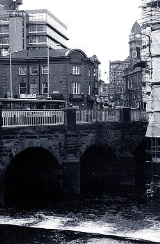
Lady's Bridge
Encyclopedia

Sheffield
Sheffield is a city and metropolitan borough of South Yorkshire, England. Its name derives from the River Sheaf, which runs through the city. Historically a part of the West Riding of Yorkshire, and with some of its southern suburbs annexed from Derbyshire, the city has grown from its largely...
, England
England
England is a country that is part of the United Kingdom. It shares land borders with Scotland to the north and Wales to the west; the Irish Sea is to the north west, the Celtic Sea to the south west, with the North Sea to the east and the English Channel to the south separating it from continental...
. It is located in the central section of the city, linking the Wicker
Wicker (Sheffield)
The Wicker is an arterial street in Sheffield, England, noted for its history and the Grade II* listed Wicker Arches viaduct that crosses it. It runs in a north-east to south-westerly direction between Lady's Bridge and Wicker Arches...
to the north with Waingate to the south.
The first bridge
The original wooden bridge at this point was constructed close to Sheffield CastleSheffield Castle
Sheffield Castle was a castle in Sheffield, England, constructed at the confluence of the River Sheaf and the River Don, possibly on the site of a former Anglo-Saxon long house, and dominating the early town. A motte and bailey castle had been constructed on the site at some time in the century...
sometime after 1150 under the orders of William de Lovetot
William de Lovetot
William de Lovetot, Lord of Hallamshire, possibly descended from the Norman Baron Ricardus Surdus, was an Anglo-Norman Baron from Huntingdonshire, often credited as the founder of Sheffield, England....
, the Norman
Normans
The Normans were the people who gave their name to Normandy, a region in northern France. They were descended from Norse Viking conquerors of the territory and the native population of Frankish and Gallo-Roman stock...
baron
Baron
Baron is a title of nobility. The word baron comes from Old French baron, itself from Old High German and Latin baro meaning " man, warrior"; it merged with cognate Old English beorn meaning "nobleman"...
who had also built the castle along with the town's first church
Sheffield Cathedral
Sheffield Cathedral is the cathedral church for the Church of England diocese of Sheffield, England. Originally a parish church, it was elevated to cathedral status when the diocese was created in 1914...
, hospital (at Spital Hill), and corn mill (at millsands).
Lady's Bridge
In 1485 the Vicar of Sheffield, Sir John Plesaunce, and William Hill, who was a master mason, both agreed to build a bridge of stone "over the watyr of Dune neghe the castell of Sheffeld" at a cost of about £67. The bridge had five arches, and was 14.5 feet (4.4 m) wide. A small chapel, dedicated to the Virgin Mary, was built close to the bridge, and the bridge became known as 'Our Lady's Bridge'. When built it could only be crossed by pedestrians as there were steps at either end of the bridge. The chapel was converted for use as a wool warehouse in 1547, to prevent its demolition as part of the Dissolution of the MonasteriesDissolution of the Monasteries
The Dissolution of the Monasteries, sometimes referred to as the Suppression of the Monasteries, was the set of administrative and legal processes between 1536 and 1541 by which Henry VIII disbanded monasteries, priories, convents and friaries in England, Wales and Ireland; appropriated their...
during the reign of Henry VIII
Henry VIII of England
Henry VIII was King of England from 21 April 1509 until his death. He was Lord, and later King, of Ireland, as well as continuing the nominal claim by the English monarchs to the Kingdom of France...
, and was subsequently used as an Alms house.
Modifications
In 1760 the bridge was widened on the upstream side, and the Alms House (formerly the chapel to Our Lady) was demolished to make way for the new structure. The bridge was widened on the downstream side in 1864, virtually obscuring the remaining original structure from view, and again in 1909, to allow trams to cross the bridge. It was restored in the late 20th century, and has been a Grade II listed structure since 1973.The Great Sheffield Flood
On the night of 11 March 1864 Lady's Bridge narrowly avoided destruction when the waters of the Great Sheffield floodGreat Sheffield Flood
Not to be confused with the floods in Sheffield in 2007.The Great Sheffield Flood was a flood that devastated parts of Sheffield, England, on 11 March 1864, when the Dale Dyke Dam broke.- Collapse of Dale Dyke Dam :...
poured over it. Nearly every other bridge upstream in the path of the flood had been smashed by the waters and the debris that they carried. A contemporary account described the scene:
2007 flooding
During the 2007 United Kingdom floods2007 United Kingdom floods
The 2007 United Kingdom floods were a series of destructive floods that occurred in various areas across the country during the summer of 2007. The most severe floods occurred across Northern Ireland on 12 June; East Yorkshire and The Midlands on 15 June; Yorkshire, The Midlands, Gloucestershire,...
, Sheffield was badly hit, and Lady's Bridge and the Wicker in particular. Lady's Bridge was overwhelmed with water as it, the Wicker and the Blonk Street Bridge were flooded, and Lady's Bridge itself was at one point reported to be in danger of collapse.

